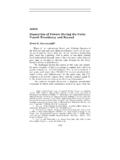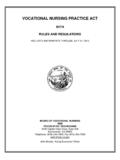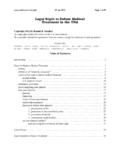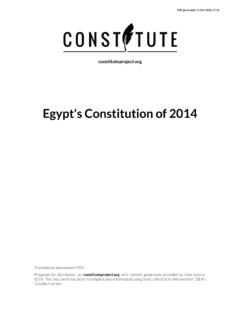Transcription of Introducing Plan Oblique Relief
1 Cartographic perspectives 21 Number 57, Spring 2007 Introducing plan Oblique ReliefBernhard JennyInstitute of CartographyETH Zurich, National Park ServiceHarpers Ferry, WV, submission, December 13, 2006; revised submission, March 14, 2007; final acceptance, March 25, 2007 INTRODUCTIONPlan Oblique Relief is a new digital technique for rendering three-dimensional terrain on otherwise planimetric (conventional flat) maps. Landforms shown realistically in side view have an illustrative quality that appeals to readers. Inspired by the work of manual mapmakers of the past, the paper begins with a historical review that includes maps by Xaver Imfeld of Switzerland, Erwin Raisz of the United States, and Heinrich Berann of Austria. In the next, digital techniques section, the projections and rendering parameters needed to create plan Oblique Relief receive attention, as does Natural Scene Designer , the first commercial software to offer this functionality.
2 The section on design takes a candid look at the advantages and disadvantages of plan Oblique Relief . The paper ends on a practical note by discussing two maps made by the authors that feature plan Oblique Relief , one a panorama and the other a physical : plan Oblique Relief , 3D digital terrain rendering, landform presented in side view and with three-dimensionality on plani-metric maps has a long history in mapmaking. As a presentation style, it draws the attention of readers, is easy to understand, and spurs the imagination. This paper offers a digital solution for creating plan Oblique Relief the name we use for the standing up style of terrain presenta-tion exemplified by the landform maps of Erwin Raisz and other terrain mapping specialists of the manual era. The term plan Oblique appeared in an article by Carlbom and Paciorek (1978) that described a technique for drafting three-dimensional buildings, which we have adapted for Relief mapping. plan Oblique Relief , however, is hardly new to mapmaking and goes by other names, most of which are arcane, polysyllabic, and difficult to remember1.
3 For the sake of consistency, in this article we use the term plan Oblique Relief shaded Relief maps and 3D perspective views are common today, plan Oblique Relief remains uncommon because, until now, no commercial software application has included it as a rendering option. The software and techniques introduced in the pages that follow provide cartographers with a means to produce plan Oblique Relief with relative ease. The choice now facing cartographers is not so much how to make plan Oblique Relief but when to use it and how best to present it topics that this paper Oblique Relief contains the characteristics of both conventional shaded Relief and 3D perspective views, such as panoramas. As the plan 1 Other names for plan Oblique Relief include: 3D planimetric Relief , high Oblique Relief , Oblique orthographic shaded Relief , landform map, mor-phographic map, physiographic map, and proportional Relief landform map. plan Oblique Relief contains the characteristics of both conventional shaded Relief and 3D perspective views, such as panoramas.
4 218/20/2007 11:15:49 AM 22 Number 57, Spring 2007 cartographic perspectives in its name suggests, plan Oblique Relief uses a planimetric base for its ini-tial construction, as do most shaded Relief maps. The Oblique in its name refers to the shallow angle used for rendering the terrain but in a man-ner that eliminates the occurrence of perspective. On conventional shaded Relief maps, terrain rendering occurs from a theoretical position directly Figure 1. Southeastern Oahu, Hawaii, rendered as conventional shaded Relief (left), plan Oblique Relief (center), and as a 3D perspective view (right). (see page 88 for color version) overhead and infinitely distant. plan Oblique Relief uses a lower position, somewhere between directly overhead (90 degrees) and the horizon (0 degrees). This results in 3D terrain that projects upwards, perpendicular to the bottom of the map and parallel to the reader s view (Figure 1). The effect of plan Oblique Relief is not unlike axonometric city maps, such as the famous Bollmann map of Manhattan (Hodgkiss, 1973), but with three-dimensionality applied not to buildings but to terrain.
5 Because plan Oblique Relief portrays the landscape much like how people see it in their everyday lives from a horizontal perspective the authors contend that it is easier for novice readers (and even experts) to understand it at a glance than to understand conventional shaded Relief . High solitary mountains, such as Mt. Fuji and Mt. Kilimanjaro, which appear as indis-tinct dots on a small-scale shaded Relief map viewed from above, reveal their recognizable forms and appear as the major mountains that they are when rendered in plan Oblique Relief . Compared to 3D perspective views that look most natural of all, plan Oblique Relief better preserves geo-graphic shapes without any front-to-back foreshortening and convergence toward a distant vanishing point. 3D perspective views mimic the view from an airplane window; plan Oblique Relief is suited to presentation of plan Oblique Relief on maps can appear in several styles ranging from high contrast line drawings to continuous tone render-ings in grayscale or color.
6 Regardless of its appearance, using plan Oblique Relief does come with a price, however. Points on the 3D terrain surface exhibit planimetric displacement with increasing altitude. For example, the base of Mt. Fuji at sea level would be planimetrically correct, but its summit would shift noticeably toward the top of the page, depending on the map scale and amount of vertical exaggeration. After the initial rendering of a plan Oblique Relief map, planimetric displacement makes it difficult to overlay data obtained from other sources, even if the projection and scale are the same. A later section will discuss this and other problems associated with plan Oblique Relief in detail. Compared to 3D perspective views that look most natural of all, plan Oblique Relief betterpreserves geographic shapes without any front-to-back foreshortening and convergence toward a distant vanishing point. 228/20/2007 11:15:49 AMcartographic perspectives 23 Number 57, Spring 2007 plan Oblique Relief OF THE MANUAL ERAA lthough new to digital cartographers, plan Oblique Relief has not always been as rare and exotic as it is today.
7 One of the earliest known maps, an approximately 5,000-year-old clay tablet from Mesopotamia, depicts mountains in profile with simple hump-shaped mounds. This example, a primitive form of plan Oblique Relief , was to reign in various forms for millennia as the dominant method of Relief portrayal on maps. Leonardo da Vinci s map of Tuscany drawn in 1502-1503 portrays hills in an Oblique fashion and with the refinement one would expect from that artist (Imhof, 1982). Even today, given a blank outline map and the pop assignment to depict the Andes, most people would fill the western edge of South America with a row of symbols that look like inverted V s. Few readers would mistake this symbology for anything other than the past two centuries as cartography became a formal profession and sought to become more scientific, so too has plan Oblique Relief . How-ever, in this same period, plan Oblique Relief fell out of vogue in favor of other methods of Relief portrayal, such as hachures, contours, hypsometric tints, and shaded Relief .
8 Although plan Oblique Relief declined in relative popularity as the profession modernized, Relief maps made during this period are among the most accomplished examples of the genre and for that matter the entire discipline. The following is a review of notable cartographers who have used plan Oblique Imfeld (1853-1909)Our review of plan Oblique Relief begins with Xaver Imfeld s Reliefkarte der Centralschweiz published in 1887, which shows the Lake Lucerne region of Switzerland with the detail and artistic refinement that hasbecome a hallmark of later Swiss topographic maps (Figure 2). Besidesbeing a cartographer, Imfeld was a talented topographer, Relief model maker, and railway engineer (Cavelti Hammer et al., 2006), factors that may have influenced his ideas about features on the Reliefkarte der Centralschweiz include southwest orientation, illumination originating from the lower right, and a Figure 2. Xaver Imfeld s Reliefkarte der Centralschweiz. (see page 88 for color version) Besides being a cartographer, Imfeld was a talentedtopographer, Relief model maker, and railway engineer (Cavelti Hammer et al.)
9 , 2006), factors that may have influenced his ideas about mapmaking. 238/20/2007 11:15:50 AM 24 Number 57, Spring 2007 cartographic perspectives ground plane depicted at two different scales. The horizontal (left to right) axis of the map is at 1:100,000-scale and the vertical (top to bottom) axis is at 1:141,000-scale. According to Imfeld s explanation on the 1898 printing of the map, the southwest orientation shows the terrain as most tourists (the potential buyers of this map) would see it as they approached the Alps from the north. The Reliefkarte der Centralschweiz was the only map made by Imfeld with three-dimensional terrain depiction; contem-porary cartographers did not imitate his technique. Although the varying ground scales technically disqualify the map as planimetric, the continu-ous-tone Relief and inclusion of glacier textures are similar to that of plan Oblique Relief created digitally. Erwin Raisz (1893 1968)The landform maps drawn by Harvard lecturer Erwin Raisz a half-century ago are the cartographic outgrowth of the physiographic block diagrams pioneered in the late 1800s by William Morris Davis and later refined by Armin Lobeck (Raisz, 1956).
10 Using only a pen, aerial photography and topographic map references, and his considerable knowledge of physical geography, Raisz depicted landforms with 50 classes of pictorial symbol-ogy selected from a pre-made library (Raisz, 1931). Raisz modified these pictorial symbols as needed to best represent intermediate landform types. With only a few expertly placed strokes of the pen Raisz captured the look of complex physical features. His maps are in essence caricatures, but with the landscape as the subject matter and accuracy a key consideration (Fig-ure 3, left). The presentation style developed by Raisz using black strokes on a white background differs from plan Oblique Relief rendered in color or shades of gray by manual or new digital methods. Raisz s technique, however, relates closely to plan Oblique Relief , since it depicts mountains with a similar side view on an approximately planimetric ground Raisz constructed his maps on flat planimetric bases, they depict the relative elevation of landforms poorly.






